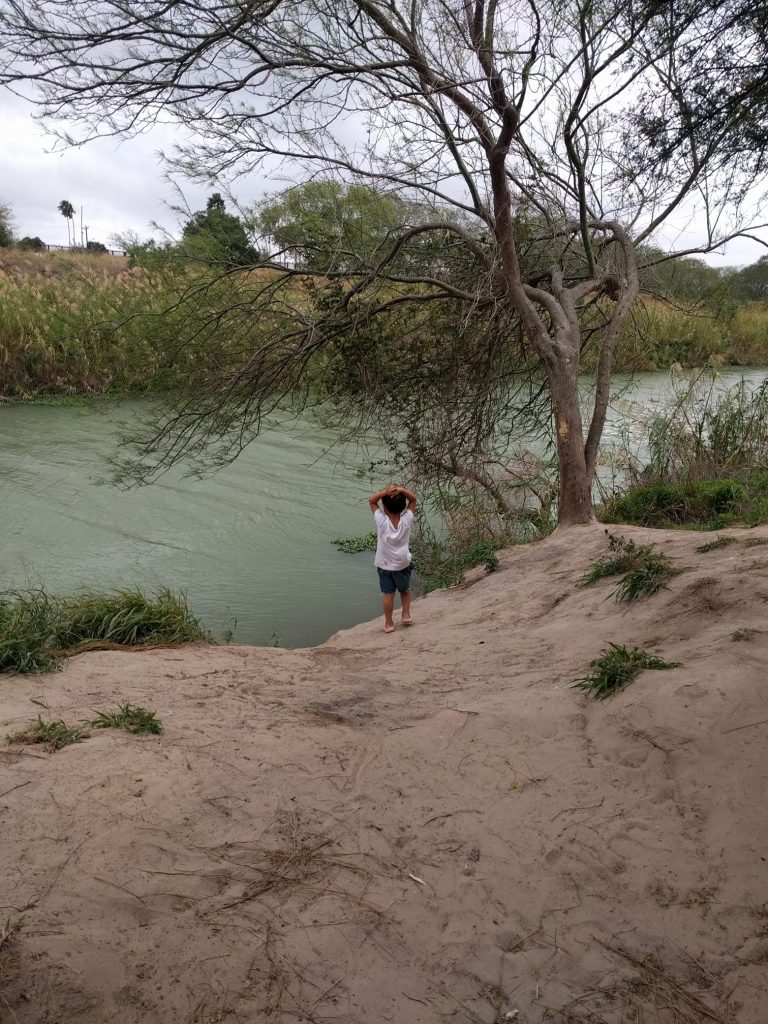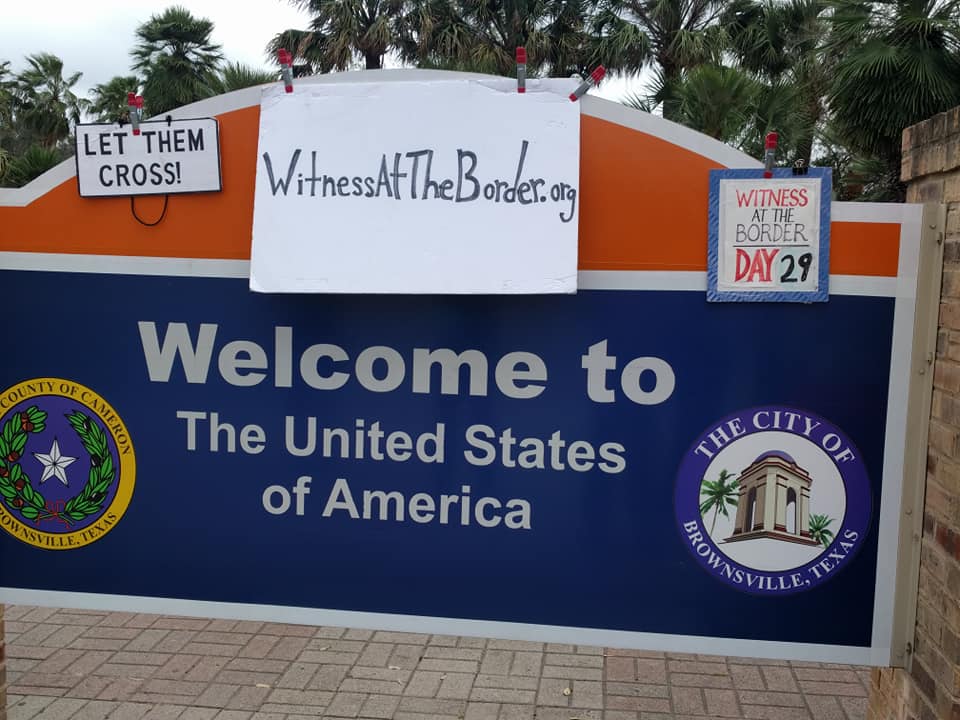by Annique Boomsma, Joan Epstein, and Karen Levine
On February 11 several of us spent about four hours in the Tent Court just on the Brownsville side of the Gateway International bridge where asylum-seekers come for their court hearings. Below is a summary of our observations, including questions that arose for us.
Our expectations going in, based on the reports of many others who had witnessed in the courts, were that that we would see a kangaroo court with a dismissive judge who would bulldoze through the legal process without any attempt to make sure asylum seekers understood the process. We expected the homeland security offers to be brusque and strict with us as visitors.
Surprisingly we were greeted respectfully by the homeland security officers, (HSO) and they were receptive to answering our questions and bent over backwards to make us comfortable while we were there. This was also the case at the Homestead detention camp.
QUESTION: Is this genuine or PR?
Both homeland security officers that we met presented a very positive picture of how migrants are treated and how many are granted asylum. The first officer told us that he saw 25 asylum-seekers “walk out this door free” last week which he said was typical. These numbers do not match publicized reports.
Our question about this, which we hope to get answered, is what percent of adjudicated asylum cases are granted asylum? We have heard from lawyers here that the number is close to nil.
Also a surprise was that this judge was a model of compassion, support, good listening, clear, kind, respectful communication and repeatedly asked asylum-seekers if they had questions.
Despite the ILLEGAL rules of the Trump administration that deny asylum seekers their LEGAL right to seek asylum, and that the judge had to follow these procedures, she went out of her way in the course of the hearing, by scheduling future hearings, to allow migrants to make their case for asylum, without ever using the word asylum. It was glaring to us that the word ASYLUM was never uttered in the court.
Once we were seated in the back of the court we observed the proceedings. In the front of the room was a large screen where we could view the judge in Harlingen 20 miles away via video camera. Seated next to the judge was a Spanish translator, and a lawyer representing the United States government was seated nearby. Migrants were seated in rows facing the screen. The HSOs in the court would be instructed by the judge to provide needed forms for each migrant during the proceedings.
The judge began with general education to all that were present about the process and what to expect at the hearing. Then she called each migrant individually, who came up to a table in the front of the camera either alone, with a spouse or with their child. We heard seven cases in total with migrants from Guatemala, Honduras, El Salvador, Cuba and Venezuela. Four had children with them ages one and a half to 12. All had arrived in Texas in mid November, except one who had arrived in August, and this was their first hearing. Most will have 3 to 4 hearings in total during which they must provide evidence for why they are afraid to return to their country of origin. The evidence they must provide consists of personal identification, medical or police reports, and affidavits from witnesses familiar with what they endured as well as any other evidence they can “reasonably provide”
QUESTION: What is considered “reasonable”? What if they fled without anything, for fear of their lives and only have their story to tell? What if reporting gang violence is never reported to the police in their country of origin because police don’t do anything to help? What happens at their next hearing then?
Each case began with the judge asking if the migrant needed time to seek legal counsel or was ready to present their case today. If they were ready to present their case today she began by reading the charges by the US government against them. The charges were “the government alleges that you are not a citizen or national of the United States and entered without inspection or documents for legal passage into the United States. Is that true ?” They all answered yes. The judge asked, “And do you understand that with this admission you are subject to removal from the United States? Do you agree?” They all said yes.
QUESTON: The change in policy of the United States has made it literally impossible for anybody seeking asylum to set even one toe onto US territory in order to legally claim asylum. The only way to enter is illegally. The logic seems to be that as you exercise your legal right to seek asylum you automatically break US law. How can this be?
The judge then asked each migrant, if they are removed by the United States, what country would they choose to go to? All said Mexico. All were then told by the judge that Mexico is not an option because it is contiguous with United States and is not a designated country for removal. All were then designated their own country of origin except one man from Guatemala who was designated to go to Honduras should he receive orders of removal. This is probably due to the new Guatemalan Asylum Cooperative Agreement which now deports many migrants often before they even have a hearing and returns them to Honduras instead of Guatemala.
Then each migrant was asked if they were afraid of returning to Mexico. Five said no, two said yes and they were taken to a private interview with a homeland security officer to decide if they would have to go back to Mexico that day. We were not permitted into that hearing and do not know the outcome.
All of the asylum-seekers in this court room were given a follow up date with the same judge for their second hearing in either April or May which will be at least six months from the time they arrived.
Today it is cold and damp and we are feeling how very hard life is for all in the camp, to have sustained this life over so many months already and with no end in sight. The judge advised everyone to seek legal assistance before they returned next time. The system is in crisis with a severe shortage of affordable or free legal representation available for the number of asylum-seekers who need legal help (as well as help translating all of their documents into English).
One asylum seeker gave as his reason for leaving Guatemala that “he wanted to have a better quality of life for himself and his six-year-old son”. The judge responded that a desire for a better life is not a criteria for seeking asylum.
QUESTION: If you come to this country from a Central American country and due to severe poverty your children are hungry, or due to climate change, that has made it impossible for you to grow the crops that sustain your livelihood or your family’s food supply, but your life was not threatened by a gun or a knife- why is this not a legal criteria to seek asylum? (Not to mention the role of the United States historically in contributing to all of these problems.)
We look forward to hearing from others who have observed in the courts. We wonder if this judge is an exception to the rule (a gorilla judge?) Or perhaps even the seemingly best of intentions and kindness may have no impact on her final ruling, under the legal constraints of this random, racist, cruel, Trump policy.
We are starting to really feel the desperation and pain of being stuck in Mexico as well as the grind of daily life in the tent encampment. We also learned that in addition to the roughly 2500 migrants in the tent encampment there are probably another 5000 migrants living on their own in the city of Matamoros, with all the same struggles and painful stories-a staggering human crisis.



 e sponsored this past Sunday on the art of children facing severe trauma by our good friend Simone Alter-Muri. She not only brought in images from the art show we have at Michelson Gallery through 2/21—but (like the show itself) brought in the historical context, discussing art that kids did in such situations as the Nazi camp at Terazin, Japanese-Americans interned by our own government in WWII, as well as kids in Darfur and Iraq.
e sponsored this past Sunday on the art of children facing severe trauma by our good friend Simone Alter-Muri. She not only brought in images from the art show we have at Michelson Gallery through 2/21—but (like the show itself) brought in the historical context, discussing art that kids did in such situations as the Nazi camp at Terazin, Japanese-Americans interned by our own government in WWII, as well as kids in Darfur and Iraq.